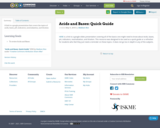
A link to a google presentation that covers the topics of acids, bases, pH, indicators, neutralization, and titration
- Subject:
- Physical Science
- Material Type:
- Unit of Study
- Date Added:
- 05/09/2018

A link to a google presentation that covers the topics of acids, bases, pH, indicators, neutralization, and titration

This workshop is designed to help you write clearly, accurately and effectively in both an academic and a professional environment. In class, we analyze various forms of writing and address problems common to advanced speakers of English. We will often read one another’s work.
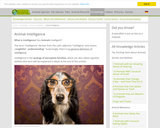
Are animals intelligent? What is intelligence? How can you tell, whether animals are intelligent?

This semester students are asked to transform the Hereshoff Museum in Bristol, Rhode Island, through processes of erasure and addition. Hereshoff Manufacturing was recognized as one of the premier builders of America’s Cup racing boats between 1890’s and 1930’s. The studio, however, is about more than the program. It is about land, water, and wind and the search for expressing materially and tectonically the relationships between these principle conditions. That is, where the land is primarily about stasis (docking, anchoring and referencing our locus), water’s fluidity holds the latent promise of movement and freedom. Movement is activated by wind, allowing for negotiating the relationship between water and land.
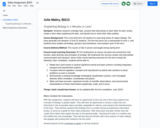
Students research a biology topic, present their discoveries to each other for peer review, create a short video explaining the topic, and decide how to share their video publicly.
With this assignment, students will have an opportunity to dive into one of the many aspects and concepts of biology in greater depth. They will have an opportunity to choose a topic they are interested in (list of possible topics provided, adaptable for others), and research the how/why/when of the topic. They will then present their findings first in a written format (a preliminary informative essay), to serve as a guide for their video production. After discussion and peer review, they will create short videos that explain the topic to the general public. Teaching this topic in a creative way will solidify their own knowledge. They will also become familiar with many aspects of video editing, and grapple with putting their creations into the world.
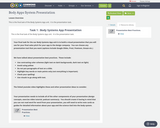
This is the final task of the Body Systems App unit. It is the presentation task.
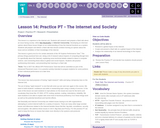
This lesson is a capstone to the Internet unit. Students will research and prepare a flash talk about an issue facing society: either **[v Net Neutrality]** or **Internet Censorship**. Developing an informed opinion about these issues hinges on an understanding of how the Internet functions as a system. Students will prepare and deliver a flash talk that should combine forming an opinion about the issue and an exhibition of their knowledge of the internet.
This lesson is good *practice* for certain elements of the AP Explore Performance Task.1 The primary things practiced here are: doing a bit of research about impacts of computing (though here it’s specifically about the Internet), explaining some technical details related to ideas in computer science, and connecting these ideas to global and social impacts. Students will practice synthesizing information, and presenting their learning in a flash talk.
1**Note:** This is NOT the official AP® Performance Task that will be submitted as part of the Advanced Placement exam; it is a practice activity intended to prepare students for some portions of their individual performance at a later time.
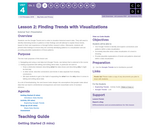
Students use the Google Trends tool in order to visualize historical search data. They will need to identify interesting trends or patterns in their findings and will attempt to explain those trends, based on their own experience or through further research online. Afterwards, students will present their findings to ensure they are correctly identifying patterns in a visualization and are providing plausible explanations of those patterns.
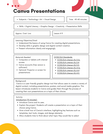
In this lesson plan, students will create informative presentations using Canva on a topic of their choice or assigned by the teacher. They will learn how to use Canva’s design tools to create visually appealing slides that effectively convey their message. Once their presentations are complete, students will present their work to the class, practicing public speaking and communication skills. This activity combines creativity with technology and enhances students' ability to organize and present information.
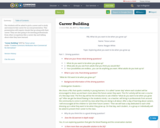
Our students will be asked to pick a career and to study and research that career for an oral presentation. This presentation will require visuals that go along with their career. They are also going to be meeting professionals from other occupations like a career day and talking about what they have learned.
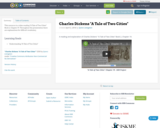
This resource is a video reading "A Tale of Two Cities" Book 2, Chapter 19. Throughout the presentation there are explanations for difficult vocabulary.

Let’s consider some common mistakes you should avoid as a presenter.
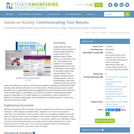
Students groups create scientific research posters to professionally present the results of their AQ-IQ research projects, which serves as a conclusion to the unit. (This activity is also suitable to be conducted independently from its unit—for students to make posters for any type of project they have completed.) First, students critically examine example posters to gain an understanding of what they contain and how they can be made most effective for viewers. Then they are prompted to analyze and interpret their data, including what statistics and plots to use in their posters. Finally, groups are given a guide that aids them in making their posters by suggesting all the key components one would find in any research paper or presentation. This activity is suitable for presenting final project posters to classmates or to a wider audience in a symposium or expo environment. In addition to the poster-making guide, three worksheets, six example posters, a rubric and a post-unit survey are provided.
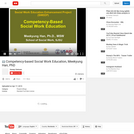
A 30 minute video introduction to competency-based social work education.
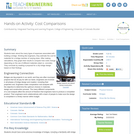
Students learn about the many types of expenses associated with building a bridge. Working like engineers, they estimate the cost for materials for a bridge member of varying sizes. After making calculations, they graph their results to compare how costs change depending on the use of different materials (steel vs. concrete). They conclude by creating a proposal for a city bridge design based on their findings.

Course information and map for first-year, in-person, 10-week class on public speaking and communication skills in delivering speeches and presentations. Includes learning objectives, assignments, readings, and other resources.

Course map for class that emphasizes developing communication skills by examining and demonstrating how self-awareness, audience, content, and occasion influence the creation and delivery of speeches and presentations. Includes learning objectives, assignments, formative feedback, learning activities, and readings as well as other resources.

First impression matters! Learn 3 quick and easy ways to create attractive and professional-looking PowerPoint title slide. These PowerPoint templates are open educational resource, created for educators, researchers and students. These templates accompanied an online workshop (see the embedded video) to learn how to make your slides look professionals.
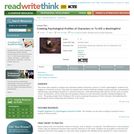
Students explore the motivation behind characters' actions in "To Kill A Mockingbird" by creating psychological profiles for characters from the novel.
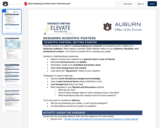
Scientific posters are a tool for communicating your researchand explaining why it matters to a particular audience. What makes a scientific poster effective relies on your audience, discipline, and professional context. You’ll want to consider who is viewing your poster.